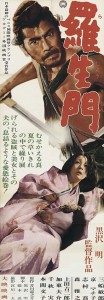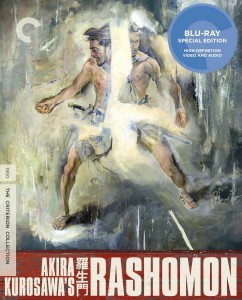After the first time I watched the film I didn’t quite get why Rashomon was held in such high regard. I understood that it was important and it was the film that, in 1950, made Akira Kurosawa’s international career. I suppose that should be a hint as to what I may not have recognized. Most of Kurosawa’s films that I highly appreciated came after Rashomon (Stray Dog and Drunken Angel aside), so it makes sense that there was clearly something that I was missing.
Strip away historical importance and you are left with a psychological courtroom drama. The key players – a bandit, a samurai, his wife, and a woodcutter – are played by Toshiro Mifune, Masayuki Mori, Machiko Kyo, and Takashi Shimura, respectively. Three of the characters, – the bandit, the wife, and the samurai – report to an unseen judge on events that took place in the wilderness. During the testimony of each character, the viewers are treated to a dramatization of the events. The first two, the bandit and the wife, are melodramatic tales that hoist the teller’s character to questionable heights while the third, from the samurai’s point of view, is told by a medium.
All of the events described at the trial are shared by the woodcutter with two other characters after the fact, as a way to pass the time during a thunderstorm. During these scenes the woodcutter admits to being a witness to the crime, but did not want to get involved in the trial.
This was the second time I watched the film and it was not until sitting down, doing additional research, and writing this that I actually felt like I had an understanding and appreciation for the film. Rashomon went on to have a strong influence over future cinema.
Consider some of your favorite courtroom dramas and then compare them to Rashomon. One of my favorites is Anatomy of a Murder, and while it does present facts and has mid-trial twists, it does not offer the level of perspective that Kurosawa provided: that we are always forced to trust the opinions of others while forming our own ideas of what happened, and that the facts often get muddled down in the aftermath.
Rashomon was filmed mostly on location, the film is a luscious piece of art. I struggle to imagine what it would look like in color with much of the action taking place in the wilderness. The picture in this version is incredibly crisp, from the shadows on the leaves to the shimmer in the growing puddles.
It may take a couple of viewings for one to really see and understand what is happening, but it is well worth the time. I will admit that during both viewings, the samurai’s story, told by the medium, seemed to be a little distracting and out of place – you will need to stick with it for the full payoff. That small gripe aside, Rashomon is very highly recommended, especially if you can get ahold of the crystal-clear Criterion Blu-ray.
Trailer
Important Links

